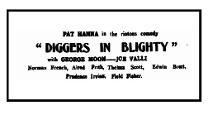AustLit
Latest Issues
AbstractHistoryArchive Description
A romance set in and around Gallipoli, in which an Englishman born in Turkey falls in love with an Armenian girl.
The film was financed and written by a Sydney cafe owner who wished to emphasise Greek contributions to the British war effort. It struggled to find a distributor.
Publication Details of Only Known VersionEarliest 2 Known Versions of
Works about this Work
-
Anzac's 'Others' : 'Cruel Huns' and 'Noble Turks'
2009
single work
criticism
— Appears in: Diasporas of Australian Cinema 2009; (p. 93-102)'War films are not an obvious starting point to discuss Australia's diasporic cinema. Nevertheless, portrayals of the enemy draw attention to the nationalizing discourses which serve to maintain an assimilationist model of the nation. While neither German nor Turkish identities figure prominently in Australia's contemporary multicultural cinema, these national 'types' play a more significant role in Australian visual culture produced in the first part of the twentieth century. German, and to a lesser extent Turkish, villains feature in numerous films produced in Australia during both world wars. In this chapter, we argue that in the short term Australian film portrayals of the 'the cruel Hun' and 'noble Turk' encouraged glorification of soldiers in Australian and New Zealand Army Corps (ANZAC), while in the long term these perpetuated a more nationalistic construction of the Anzac legend' (Publication abstract)
-
Anzac's 'Others' : 'Cruel Huns' and 'Noble Turks'
2009
single work
criticism
— Appears in: Diasporas of Australian Cinema 2009; (p. 93-102)'War films are not an obvious starting point to discuss Australia's diasporic cinema. Nevertheless, portrayals of the enemy draw attention to the nationalizing discourses which serve to maintain an assimilationist model of the nation. While neither German nor Turkish identities figure prominently in Australia's contemporary multicultural cinema, these national 'types' play a more significant role in Australian visual culture produced in the first part of the twentieth century. German, and to a lesser extent Turkish, villains feature in numerous films produced in Australia during both world wars. In this chapter, we argue that in the short term Australian film portrayals of the 'the cruel Hun' and 'noble Turk' encouraged glorification of soldiers in Australian and New Zealand Army Corps (ANZAC), while in the long term these perpetuated a more nationalistic construction of the Anzac legend' (Publication abstract)
-
Gallipoli,
cTurkey,cMiddle East, Asia,
- 1915





